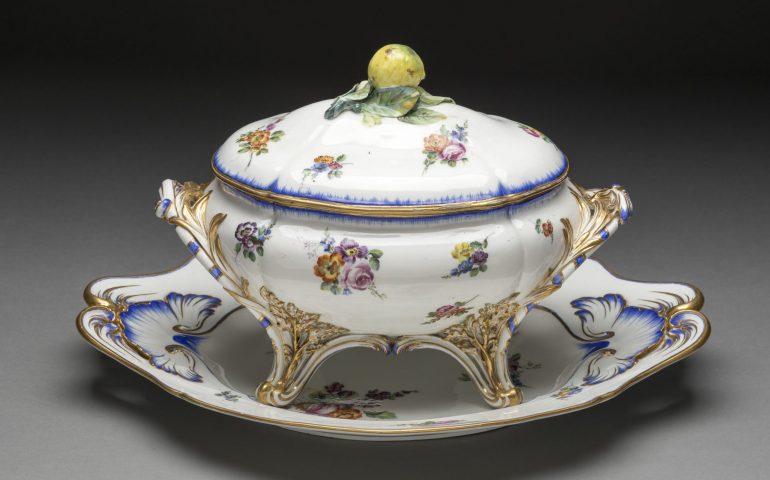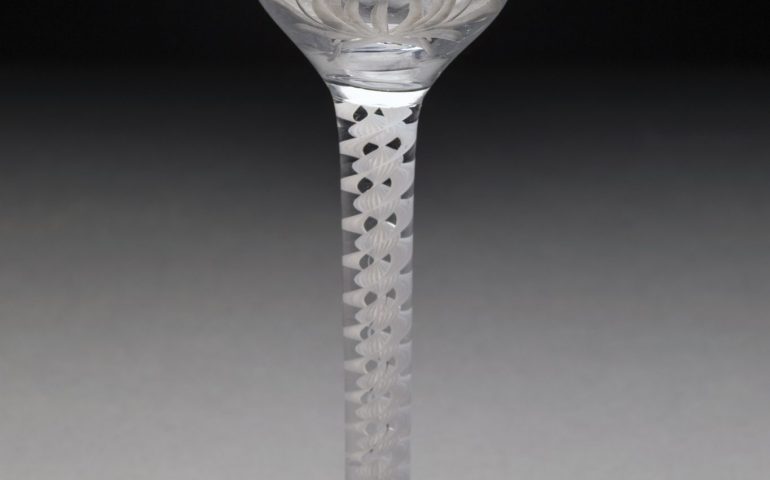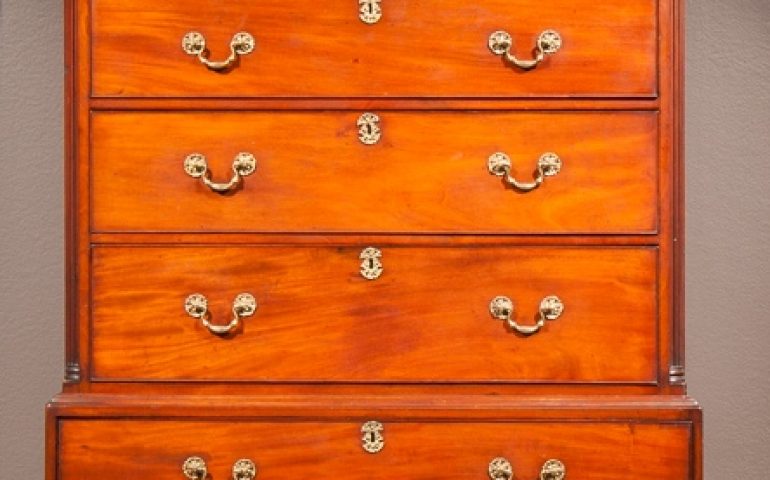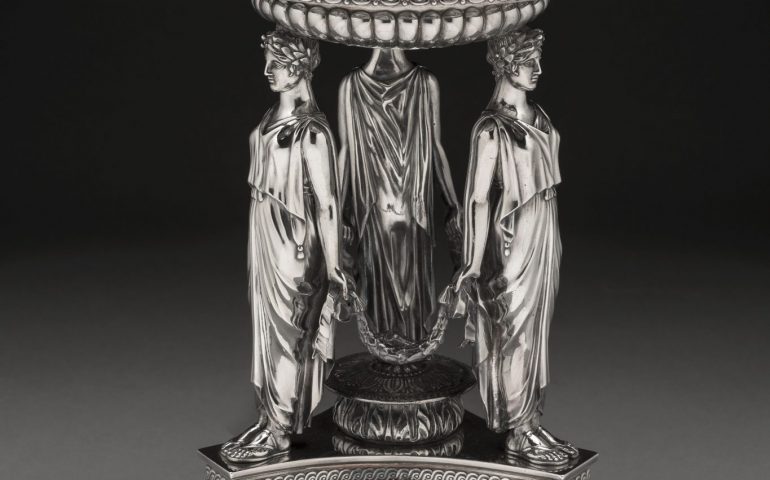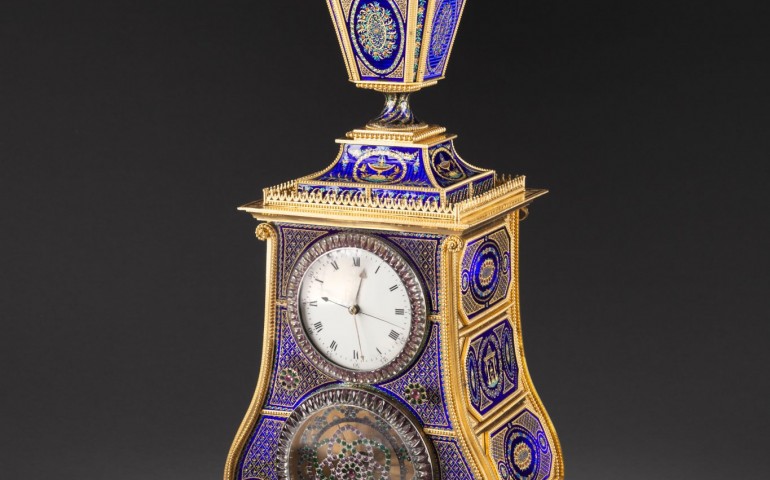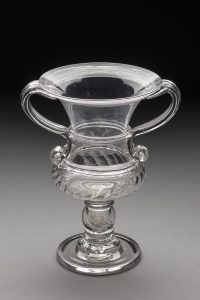
New England Glass Company (Massachusetts, active 1818–1888), Vase with Coin, c. 1840, Glass, free blown, with 1816 English coin, Gift of Melvin P. Billups in memory of his wife, Clarice Marston Billups, 64.175
Whimsical porcelain figures, enchanting miniature portraits, and a dazzling array of historical glass have been among NOMA’s visitor favorites for decades. The museum is pleased to announce that the Lupin Foundation Decorative Arts Galleries on the second floor are reopening with a reimagined installation. In a series of gallery unveilings through 2017 and 2018, and with the creation of the Elise M. Besthoff Foundation changing gallery, NOMA will celebrate its beloved collection of design, craft, and ornament. These new installations carry forward a curatorial initiative to integrate collections across material and culture, to provide layered interpretation, and to present the best of our Gulf region’s artistic expression in context with our encyclopedic collection covering ancient to contemporary arts.
When the first of the Lupin Galleries opened on March 16, for the first time the finest of NOMA’s more than 10,000 pieces of ceramics, glass, furniture, silver, and portrait miniatures were installed together with fine arts. This new presentation highlights connections — between glass vessels and mahogany furniture, between European and American designs, and between tiny portrait miniatures and monumental silver centerpieces. With an installation that looks both deeply and broadly at 18th- and early 19th-century design and art in both America and Europe, the first of the Lupin Galleries focuses on NOMA’s foundational collections in the decorative arts — the Kuntz family collection gifted in 1979 and the Billups glass collection gifted in 1955.
In the mid-20th century, New Orleanian Felix Hurwig Kuntz (1890–1971) amassed significant collections of American letters, ephemera, paintings, and antiques from the Colonial and early Federal periods. The manuscript collection went to the Tulane Library, and his heirs oversaw the donation of the Kuntz American decorative arts collection to NOMA in 1979. This new installation unites, for the first time, the finest of the Kuntz furniture collection with paintings by such American luminaries as John Singleton Copley and Benjamin West, alongside stylistic antecedents in superb European decorative arts and one of the nation’s most renowned collections of early American glass.
Two Kuntz treasures on view poignantly show the transition from the natural motifs of the Rococo style to the stately Neoclassical, a style evolution contemporaneous with the American Revolution. A c. 1780 chest-on-chest made in Philadelphia, attributed to cabinet maker Thomas Affleck, has the proportions, columns and sharp, architectural pediment of the Classical style, but also a nodto the Rococo with its asymmetrical flower bouquet finial. James Claypoole Jr.’s 1774 painting Memorial to E.R. has romantic floral garlands in the Rococo taste, but its Grecian dress and urn make the painting a notably early example of the Neoclassical style in America. The new gallery places these transitional American artworks together with European examples of the Rococo and Neoclassical styles, including Meissen porcelain, a dramatic English pagoda-shaped silver epergne, and a large porcelain soup tureen made in 1754 in Vincennes, France, before the world-famous French National Porcelain Manufactory moved to its longtime home at Sèvres in 1756.
With a dazzling large display of glass vessels, this first gallery also highlights the Melvin P. Billups collection. Billups assembled one of America’s most important glass collections in the 1950s, amassing more than 1,000 pieces that cover three millennia of glass craft and technology. In 1955 Billups chose to honor his wife, New Orleans native Clarice Marston Billups, by donating the collection in her memory to NOMA. This first Lupin gallery exhibits deep and important examples from the Billups Collection of the glass industry’s flourishing in the early American Federal period.
Through the next two years, objects representing high Victorian styles, the turn-of-the-century ornamental revolution, and 20th-century Modernism will join the conversation. Forthcoming are installations dedicated to New Orleans and aesthetic preferences of the American South — from Gorham’s luscious Art Nouveau Martelé silver to a large expression of French Art Glass and American Art Pottery — along with the museum’s latest efforts to bring our collection further into the 20th century and to engage with 21st-century designers working in new craft and technology mediums.
— Mel Buchanan, RosaMary Curator of Decorative Arts and Design
